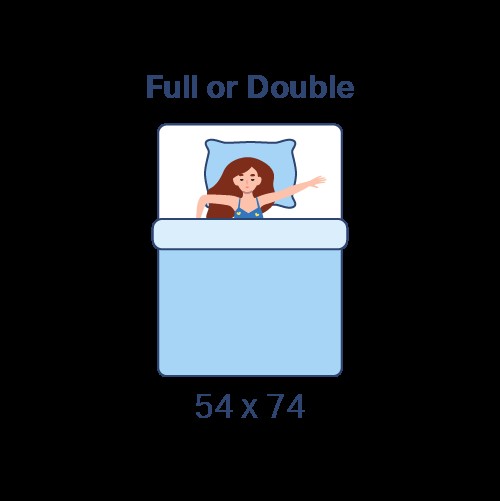Buying a new bed is a significant decision, often influenced by factors like room size and budget. Choosing a bed that’s larger than necessary can lead to unnecessary expenses, as larger mattresses require bigger frames, sheets, and blankets, quickly inflating the overall cost.
A full size bed, often referred to as a “double bed”, strikes a balance. It offers more width than a twin bed but remains more compact than a queen. This makes it a popular choice, especially for individuals sleeping alone, those with smaller bedrooms, or anyone looking for a cost-effective yet comfortable sleep solution. Full beds can also be practical in shared kids’ rooms or guest rooms where maximizing space is key.
Let’s delve into the standard dimensions of a full size bed and compare it with other mattress sizes to help you determine if it’s the perfect fit for your needs.
Understanding the Dimensions of a Full Size Bed
A full size bed, also known as a double bed, measures precisely 54 inches in width and 75 inches in length. This translates to 4 feet 6 inches wide and 6 feet 3 inches long. In metric measurements, this is approximately 137 cm wide and 190 cm long.
While the width and length are standardized, the thickness of a full size mattress can vary. Typically, you’ll find full mattresses ranging from 8 to 14 inches thick. A thicker mattress can enhance comfort and potentially increase durability. However, keep in mind that thicker mattresses might require bed sheets with deeper pockets to ensure a secure and proper fit around the edges.
Full size beds are particularly well-suited for bedrooms where space is a consideration. They provide ample sleeping space for a single adult who appreciates extra room to stretch out compared to a narrower twin mattress. Furthermore, a full bed can comfortably accommodate two small children sharing a room, or serve as a cozy option for a parent and a young child.
Exploring Standard Mattress Sizes
The mattress industry generally recognizes six standard sizes, ranging from the smallest twin to the largest California king. While these are standard measurements, it’s always wise to double-check the manufacturer’s specifications before purchasing, as slight variations can occur between brands. Ensuring the mattress dimensions align with your bed frame is crucial for a proper fit.
Mattresses are generally categorized by the number of sleepers they comfortably accommodate. Twin, twin XL, and full mattresses are primarily designed for single sleepers. Queen, king, and California king sizes are built to comfortably sleep two adults, and sometimes even more depending on sleeping habits and preferences.
Here’s a helpful table summarizing the standard dimensions of each mattress size:
| Mattress Size | Dimensions (Width x Length) | Common Uses |
|---|---|---|
| Twin | 38” x 75” | Children’s rooms, bunk beds, small bedrooms |
| Twin XL | 38” x 80” | College dorms, taller individuals, single sleepers |
| Full | 54” x 75” | Single adults, teens, guest rooms, couples who prefer a smaller bed |
| Queen | 60” x 80” | Couples, master bedrooms, guest rooms |
| King | 76” x 80” | Couples who want extra space, master bedrooms |
| California King | 72” x 84” | Taller couples, narrower master bedrooms |


Full Size Bed Versus Queen Size Bed
Queen size beds are a step up in size, measuring 6 inches wider and 5 inches longer than full size mattresses. This extra space, particularly the added width, makes a significant difference for couples, allowing two adults to sleep comfortably without feeling cramped. This is why queen beds are a popular choice for couples and master bedrooms.
However, full size beds offer distinct advantages. Their smaller footprint is beneficial in bedrooms with limited square footage. In smaller rooms, the space saved by choosing a full bed can be substantial, allowing for more furniture or open space. Another key benefit is the price point. Full mattresses generally come with a lower price tag compared to queen mattresses, making them a budget-friendly option.
For individuals who move frequently, full beds are also easier to handle and transport. The smaller dimensions simplify navigating stairs, hallways, and doorways during a move, which can be a significant advantage compared to the bulkier queen size.
Is a Full Size Bed the Right Choice for You? Factors to Consider
Choosing the right mattress size involves considering various factors to ensure it aligns with your lifestyle and needs. Let’s explore the key considerations to help you decide if a full size bed is the optimal choice for you.
Number of Sleepers
The number of people (or pets!) sleeping in the bed is a primary factor. A full bed’s 54-inch width provides comfortable space for a single adult to sleep and move freely. It’s also suitable for a single adult plus a small pet. For co-sleeping arrangements, a full bed can work for an adult sharing with a young child or for two younger children sharing a bed.
However, for couples, a queen bed is generally recommended. The extra 6 inches of width in a queen bed provides significantly more personal space for each partner, minimizing sleep disturbance and maximizing comfort for two adults sharing a bed.
Height of the Sleeper
Your height plays a role in mattress selection. If you are 6 feet tall or taller, you might find a full bed (at 75 inches long) or even a twin bed restrictive in length, potentially leading to discomfort as your feet may hang off the edge.
For taller individuals, longer mattresses like a twin XL, queen, or king (all 80 inches long) are more suitable. California king beds offer the most length at 84 inches, ideal for very tall individuals. Conversely, if you are shorter, you might find the dimensions of a full or twin bed perfectly comfortable and even prefer the more compact feel compared to a larger mattress.
Preferred Sleep Position
Your preferred sleep position can also influence the ideal mattress size. Back and stomach sleepers often spread out more during sleep, requiring more surface area, especially in length. For these sleep positions, a queen or king bed might offer the most comfortable space.
Side sleepers, who often sleep in a more curled or fetal position, may find a twin or full bed sufficiently spacious in length. The key is to consider how much space you naturally occupy in your sleep and choose a mattress that accommodates your movements and preferred position.
Bedroom Dimensions
The size of your bedroom is a practical constraint. Ideally, you should aim for at least two feet of clearance on both sides of the bed and at the foot of the bed for easy movement and access. To comfortably accommodate a full bed along with other essential bedroom furniture like dressers and nightstands, a bedroom of at least 120 square feet is generally recommended.
Full beds are excellent space-saving choices, especially for guest rooms or smaller bedrooms. Their compact size allows for more flexibility in room layout and can free up valuable floor space. For narrow bedrooms, a twin, twin XL, or full bed may be the most practical choice, while larger bedrooms can better accommodate queen or king beds.
Budget Considerations
Budget is always a factor in purchasing decisions. Full beds, along with twin and twin XL sizes, are generally more affordable than queen, king, and California king mattresses. The cost savings extend beyond the mattress itself, as smaller beds require less expensive bed frames, sheets, and other bedding accessories.
Choosing a full bed over a queen bed can lead to significant savings on the overall cost of setting up your sleep space, making full beds a particularly attractive option for budget-conscious shoppers.
Conclusion
Full size beds offer a versatile and practical sleep solution, particularly for single individuals, teens, and guest rooms. Understanding “How Big Is A Full Size Bed” and its dimensions compared to other mattress sizes is crucial in making an informed decision. By considering factors like the number of sleepers, height, sleep position, bedroom size, and budget, you can determine if a full size bed is the perfect fit for your needs and enjoy a comfortable and restful night’s sleep.

